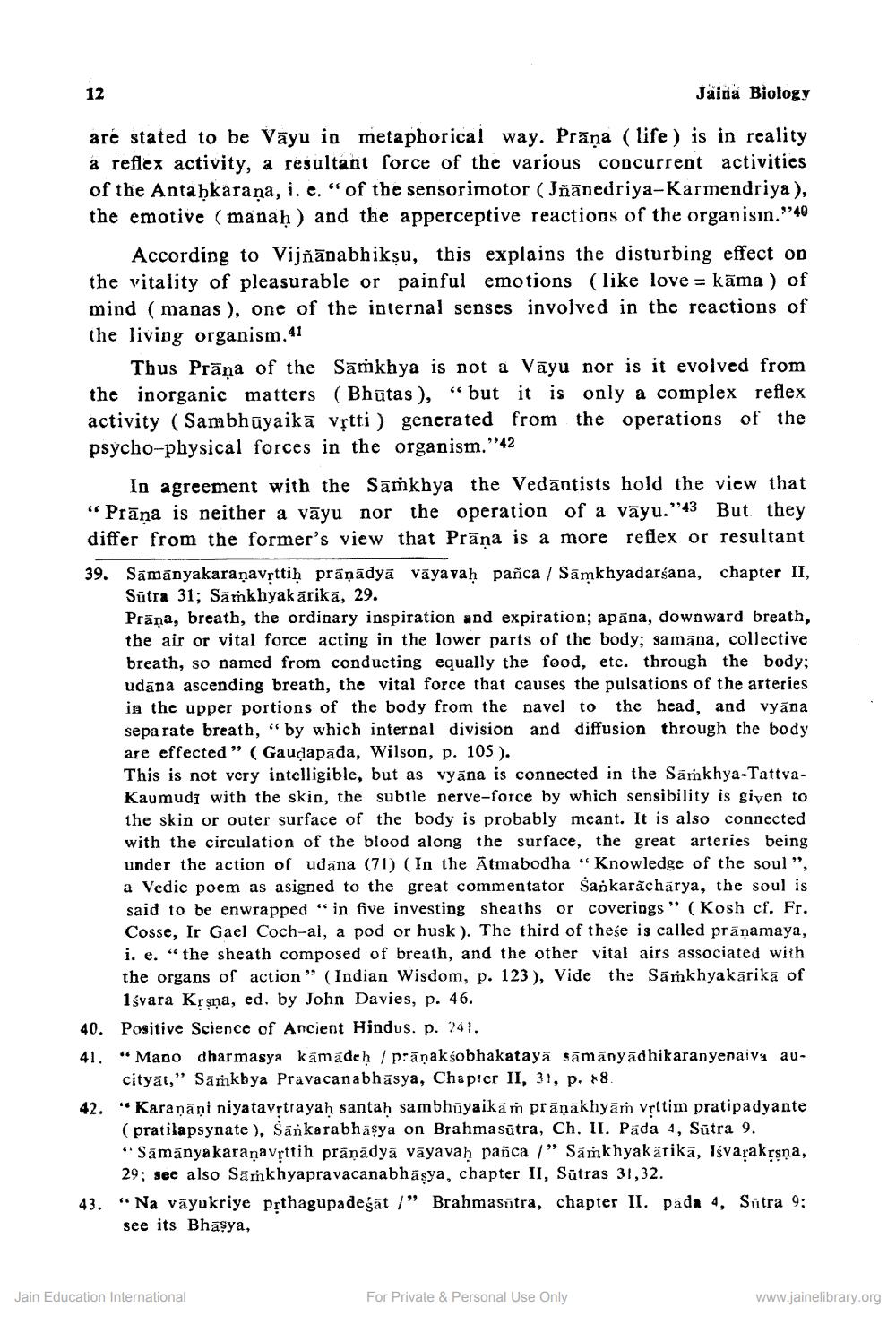________________
12
Jaina Biology
are stated to be Vayu in metaphorical way. Prāņa ( life ) is in reality à reflex activity, a resultant force of the various concurrent activities of the Antahkarana, i. e. “ of the sensorimotor (Jñānedriya-Karmendriya), the emotive (manah) and the apperceptive reactions of the organism."40
According to Vijñānabhikṣu, this explains the disturbing effect on the vitality of pleasurable or painful emotions (like love = kāma ) of mind (manas), one of the internal senses involved in the reactions of the living organism.41
Thus Prāņa of the Sāmkhya is not a Vāyu nor is it evolved from the inorganic matters (Bhūtas ), “but it is only a complex reflex activity (Sambhūyaikā vịtti) generated from the operations of the psycho-physical forces in the organism."'42
In agreement with the Samkhya the Vedāntists hold the view that “Prāna is neither a vāyu nor the operation of a vāyu.”43 But they differ from the former's view that Prāna is a more reflex or resultant
39. Sāmānyakaraṇavịttiḥ prāņādyā vāyavah panca / Samkhyadarśana, chapter II,
Sūtra 31; Samkhyakārikā, 29. Prāna, breath, the ordinary inspiration and expiration; apāna, downward breath, the air or vital force acting in the lower parts of the body; samana, collective breath, so named from conducting equally the food, etc. through the body; udāna ascending breath, the vital force that causes the pulsations of the arteries in the upper portions of the body from the navel to the head, and vyāna separate breath, “ by which internal division and diffusion through the body are effected” (Gaudapāda, Wilson, p. 105 ). This is not very intelligible, but as vyāna is connected in the Samkhya-TattvaKaumudi with the skin, the subtle nerve-force by which sensibility is given to the skin or outer surface of the body is probably meant. It is also connected with the circulation of the blood along the surface, the great arteries being under the action of udāna (71) (In the Ātmabodha “Knowledge of the soul ”, a Vedic poem as asigned to the great commentator Sankarãchārya, the soul is said to be enwrapped "in five investing sheaths or coverings " (Kosh cf. Fr. Cosse, Ir Gael Coch-al, a pod or husk ). The third of these is called pränamaya, i. e. “the sheath composed of breath, and the other vital airs associated with the organs of action” (Indian Wisdom, p. 123), Vide the Samkhyakārikā of
1śvara Krşna, ed. by John Davies, p. 46. 40. Positive Science of Ancient Hindus. p. 241.
"Mano dharmasya kamadeh / prāņaksobhakataya sāmányadhikaranyenaiva aucityāt," Sāmkbya Pravacanabhāsya, Chap'er II, 31, p. *8. "Karanāņi niyatavrtrayah santah sambhūyaikāṁ prāņākhyām Vșttim pratipadyante (pratilapsynate), Sārkarabhāsya on Brahma sūtra, Ch. II. Pada 4, Sūtra 9. * Sāmānya karana Vrttih prāņādyā vāyavah panca /” Samkhyakärikā, Isvarakrsna,
29; see also Sārkhyapravacanabhāşya, chapter II, Sūtras 31,32. 43. “Na vāyukriye pệthagupadeśāt /” Brahmasūtra, chapter II. pada 4, Sūtra 9;
see its Bhasya,
Jain Education International
For Private & Personal Use Only
www.jainelibrary.org




